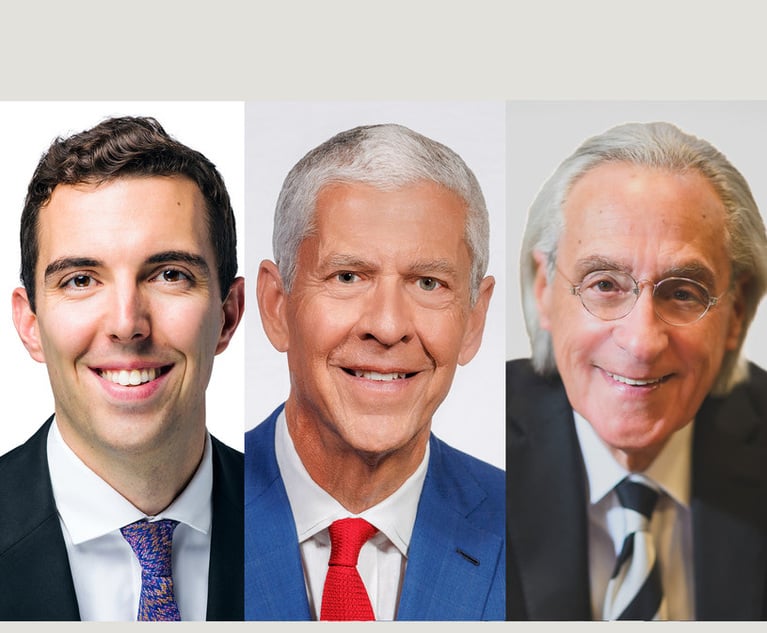Calif. Supremes Embrace Worker-Friendly Classification Test. Why This Matters to Gig Companies
“The result will be sweeping reclassification of workers throughout the state, including in the gig economy where much of the litigation has recently focused,” Michael Rubin of Altshuler Berzon says.
April 30, 2018 at 03:21 PM
6 minute read
The original version of this story was published on The Recorder
 California Supreme Court building on 350 McAllister St., San Francisco, California, 94102 (Photo: Jason Doiy/ALM)
California Supreme Court building on 350 McAllister St., San Francisco, California, 94102 (Photo: Jason Doiy/ALM)
Updated on May 1 at 7:30AM PST
The California Supreme Court adopted a new worker-friendly standard Monday to determine a central question for gig economy companies whose business models depend on classifying workers as independent contractors rather than employees.
The court, ruling in the case Dynamex Operations West v. Superior Court, embraced a more rigid test than the current, looser standard for determining whether a worker is an employee or a contractor. The closely watched case presents significant implications for worker classification in the gig economy. Cases in state courts were paused in anticipation of the ruling.
Altshuler Berzon attorney Michael Rubin, who filed an amicus brief in the case in support of the workers, said the opinion “provides needed clarity to worker and employers alike, slicing through decades of confusing and inconsistent case law to focus on the key practical inquiry: where the worker 'would ordinarily be viewed as working in the hiring business.'”
He added, “The result will be sweeping reclassification of workers throughout the state, including in the gig economy where much of the litigation has recently focused.”
A team from Littler Mendelson and McDermott Will & Emery represented Dynamex. Attorneys for the company did not immediately respond to a request for comment.
In the wage-and-hour class action, a Dynamex delivery driver named Charles Lee claimed he and his fellow workers were misclassified as independent contractors. At oral arguments, the lawyers in the case were asked to argue about whether California should abandon its current test for determining who is an employee or adopt a more worker-friendly standard.
Worker classification is a central issue in the gig economy. Many large companies, including Uber Technologies Inc. and Lyft Inc., are built on the backs of independent contractors. Employees, under the federal labor structure, are guaranteed collective bargaining rights, health care benefits and worker compensation. Gig companies contend their workforce enjoys more flexibility, setting hours and pace on their own.
Judges across the country have grappled in recent years with worker classification in the sharing economy. Grubhub prevailed in a trial over this issue of misclassification last year. The court sided with the company and found that the driver was an independent contractor. With that case now on appeal, it will now be governed by the new standard set in Dynamex.
“In recent years, the relevant regulatory agencies of both the federal and state governments have declared that the misclassification of workers as independent contractors rather than employees is a very serious problem, depriving federal and state governments of billions of dollars in tax revenue and millions of workers of the labor law protections to which they are entitled,” the California Supreme Court said.
Rubin said there are likely hundreds of other misclassification cases pending that will be affected by the decision, including many in the gig economy.
The decision falls only under California law, but it follows a New Jersey Supreme Court decision. Several other states have more worker-friendly tests, in different forms, to determine how to classify an employee. Rubin predicted that more states are likely to follow suit, following the California decision.
“As the federal government increasingly abandons its past commitment to protecting workplace rights, the states are stepping up to fill the gaps,” Rubin said.
Dynamex argued that the current standard, in place since 1989, should be used. The older standard is a multifactor test that focuses mostly on whether the employer has control in the way the worker performs. It considers various other factors, including the worker's skill, the method of payment and the nature of the business.
The lawyers for the workers successfully urged the California Supreme Court to embrace a so-called “ABC test,” which is used in New Jersey and Massachusetts.
That test requires the employer to establish three factors to show a worker is an independent contractor: ”that the worker is free from the control and direction of the hirer in connection with the performance of the work, both under the contract for the performance of such work; that the worker performs work that is outside the usual course of the hiring entity's business; and that the worker is customarily engaged in an independently established trade, occupation or business of the same nature as the work performed for the hiring entity.”
The Supreme Court wrote: “It bears emphasis that in order to establish that a worker is an independent contractor under the ABC standard, the hiring entity is required to establish the existence of each of the three parts of the ABC standard.”
The plaintiffs were represented by A. Mark Pope of Pope, Berger, Williams & Reynolds and Kevin Ruf of Glancy Prongay & Murray.
'This could ruin the gig economy'
Fisher & Phillips partner Richard Meneghello said the “ABC” test “makes it very difficult, if not impossible, for your average gig company to label its workers as contractors.” He wrote in a blog post that the “ABC” test essentially presumes an individual in question is an employee unless the employer proves three specific criteria.
Meneghello said the requirements would be nearly impossible for gig economy companies to comply with if they want to keep their workers classified as independent contractors.
“This could ruin the gig economy as we know it. After all, a great many of those providing services for gig companies—taking advantage of their idle capacity so they can fill a specific need and make some extra money—are handling these jobs as side hustles,” Meneghello said. “They are not running an independently established trade, occupation, profession or business. And moreover, how would a gig economy business confirm that their workers are meeting these standards?”
California companies, leading in the gig workforce model, should be thinking about the Dynamex case and any consequences, a team from Paul Hastings said in a recent blog post. In anticipation of the ruling, the lawyers recommended that companies look closely at worker relationships and to “take steps to assess their potential risk.”
Correction: An earlier version of this story misidentified the lawyer who represented the plaintiffs.
This content has been archived. It is available through our partners, LexisNexis® and Bloomberg Law.
To view this content, please continue to their sites.
Not a Lexis Subscriber?
Subscribe Now
Not a Bloomberg Law Subscriber?
Subscribe Now
NOT FOR REPRINT
© 2025 ALM Global, LLC, All Rights Reserved. Request academic re-use from www.copyright.com. All other uses, submit a request to [email protected]. For more information visit Asset & Logo Licensing.
You Might Like
View All
The Right Amount?: Federal Judge Weighs $1.8M Attorney Fee Request with Strip Club's $15K Award

Kline & Specter and Bosworth Resolve Post-Settlement Fighting Ahead of Courtroom Showdown
6 minute read
12-Partner Team 'Surprises' Atlanta Firm’s Leaders With Exit to Launch New Reed Smith Office
4 minute read
Morgan Lewis Shutters Shenzhen Office Less Than Two Years After Launch
Trending Stories
- 1How ‘Bilateral Tapping’ Can Help with Stress and Anxiety
- 2How Law Firms Can Make Business Services a Performance Champion
- 3'Digital Mindset': Hogan Lovells' New Global Managing Partner for Digitalization
- 4Silk Road Founder Ross Ulbricht Has New York Sentence Pardoned by Trump
- 5Settlement Allows Spouses of U.S. Citizens to Reopen Removal Proceedings
Who Got The Work
J. Brugh Lower of Gibbons has entered an appearance for industrial equipment supplier Devco Corporation in a pending trademark infringement lawsuit. The suit, accusing the defendant of selling knock-off Graco products, was filed Dec. 18 in New Jersey District Court by Rivkin Radler on behalf of Graco Inc. and Graco Minnesota. The case, assigned to U.S. District Judge Zahid N. Quraishi, is 3:24-cv-11294, Graco Inc. et al v. Devco Corporation.
Who Got The Work
Rebecca Maller-Stein and Kent A. Yalowitz of Arnold & Porter Kaye Scholer have entered their appearances for Hanaco Venture Capital and its executives, Lior Prosor and David Frankel, in a pending securities lawsuit. The action, filed on Dec. 24 in New York Southern District Court by Zell, Aron & Co. on behalf of Goldeneye Advisors, accuses the defendants of negligently and fraudulently managing the plaintiff's $1 million investment. The case, assigned to U.S. District Judge Vernon S. Broderick, is 1:24-cv-09918, Goldeneye Advisors, LLC v. Hanaco Venture Capital, Ltd. et al.
Who Got The Work
Attorneys from A&O Shearman has stepped in as defense counsel for Toronto-Dominion Bank and other defendants in a pending securities class action. The suit, filed Dec. 11 in New York Southern District Court by Bleichmar Fonti & Auld, accuses the defendants of concealing the bank's 'pervasive' deficiencies in regards to its compliance with the Bank Secrecy Act and the quality of its anti-money laundering controls. The case, assigned to U.S. District Judge Arun Subramanian, is 1:24-cv-09445, Gonzalez v. The Toronto-Dominion Bank et al.
Who Got The Work
Crown Castle International, a Pennsylvania company providing shared communications infrastructure, has turned to Luke D. Wolf of Gordon Rees Scully Mansukhani to fend off a pending breach-of-contract lawsuit. The court action, filed Nov. 25 in Michigan Eastern District Court by Hooper Hathaway PC on behalf of The Town Residences LLC, accuses Crown Castle of failing to transfer approximately $30,000 in utility payments from T-Mobile in breach of a roof-top lease and assignment agreement. The case, assigned to U.S. District Judge Susan K. Declercq, is 2:24-cv-13131, The Town Residences LLC v. T-Mobile US, Inc. et al.
Who Got The Work
Wilfred P. Coronato and Daniel M. Schwartz of McCarter & English have stepped in as defense counsel to Electrolux Home Products Inc. in a pending product liability lawsuit. The court action, filed Nov. 26 in New York Eastern District Court by Poulos Lopiccolo PC and Nagel Rice LLP on behalf of David Stern, alleges that the defendant's refrigerators’ drawers and shelving repeatedly break and fall apart within months after purchase. The case, assigned to U.S. District Judge Joan M. Azrack, is 2:24-cv-08204, Stern v. Electrolux Home Products, Inc.
Featured Firms
Law Offices of Gary Martin Hays & Associates, P.C.
(470) 294-1674
Law Offices of Mark E. Salomone
(857) 444-6468
Smith & Hassler
(713) 739-1250








